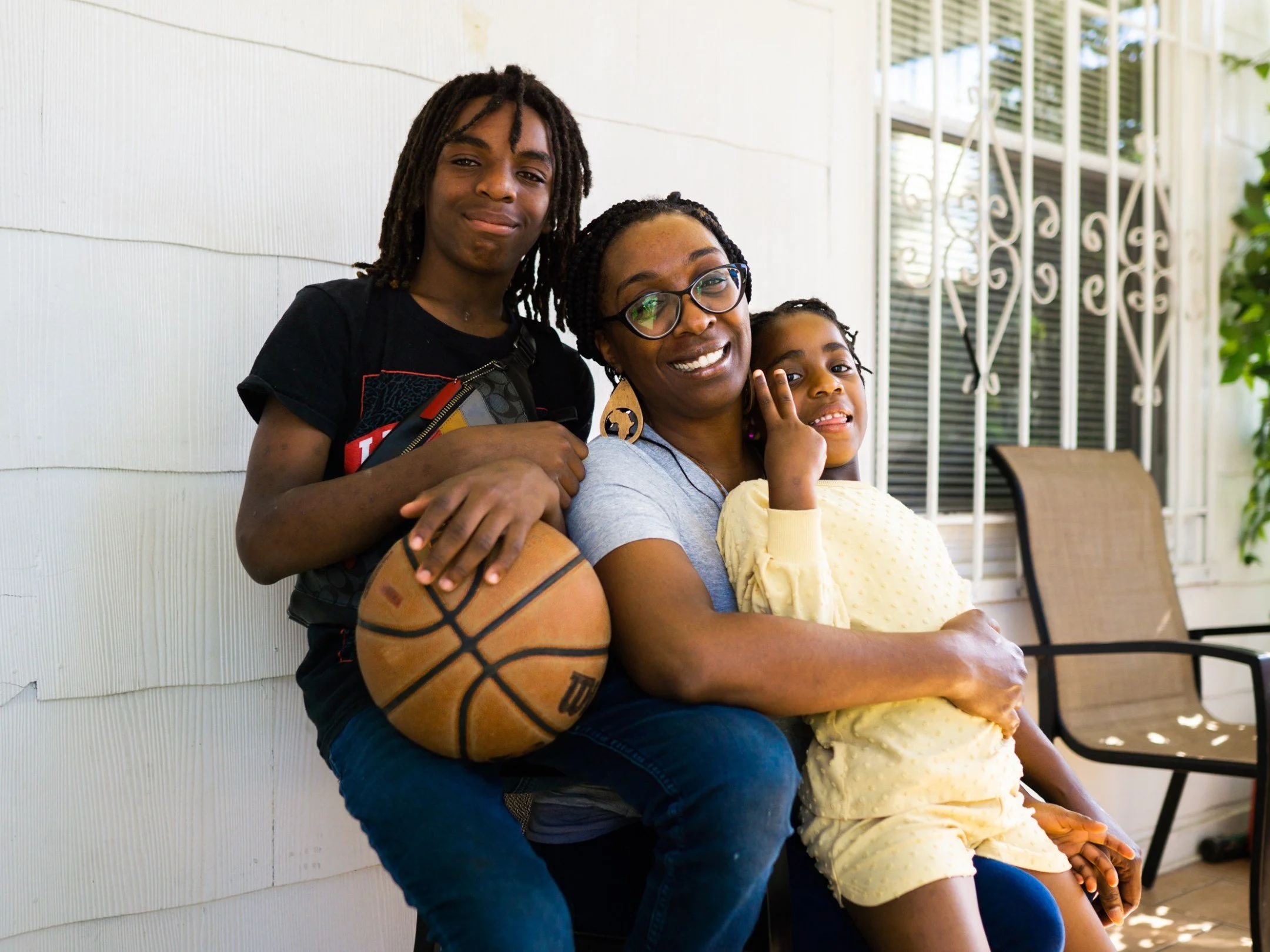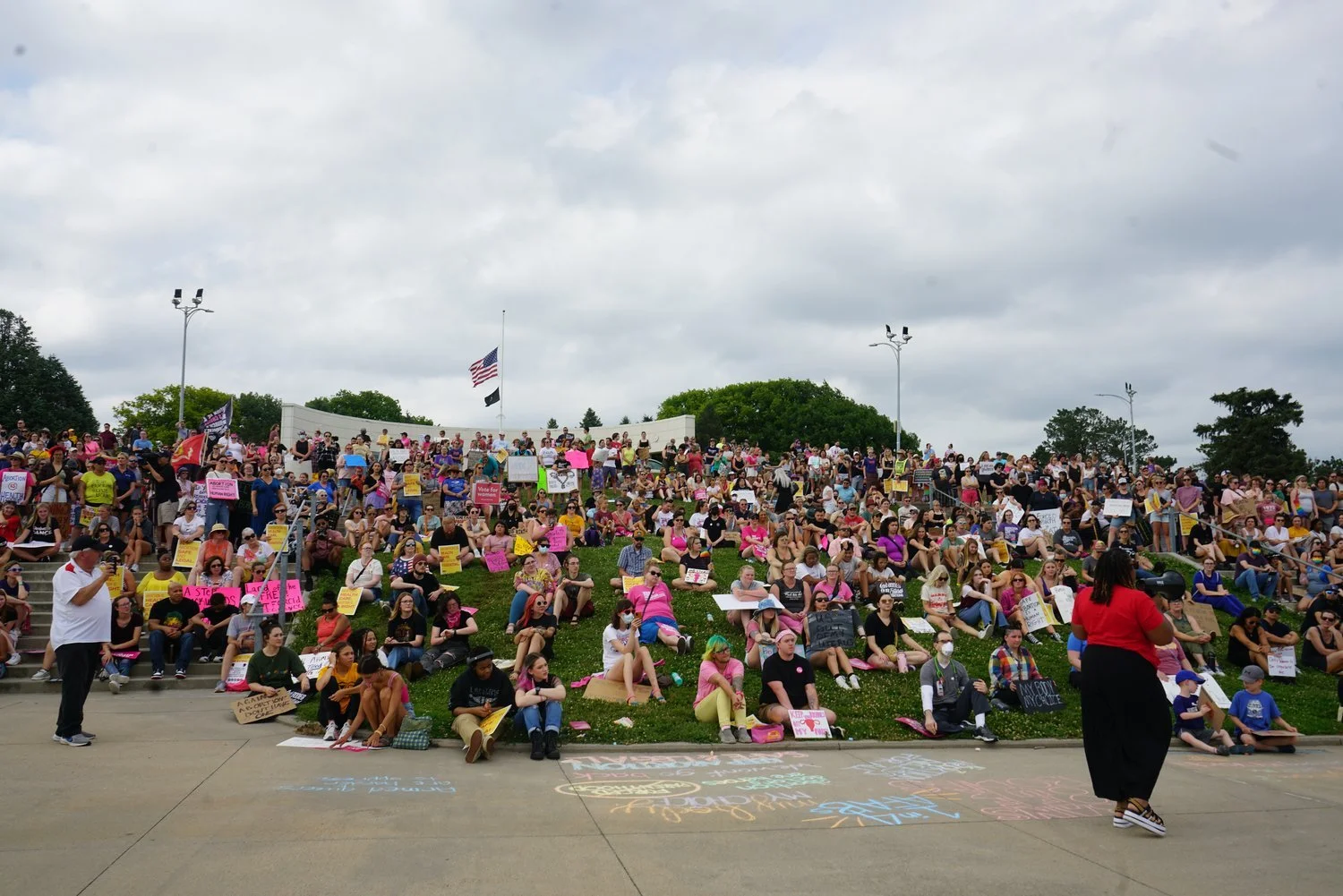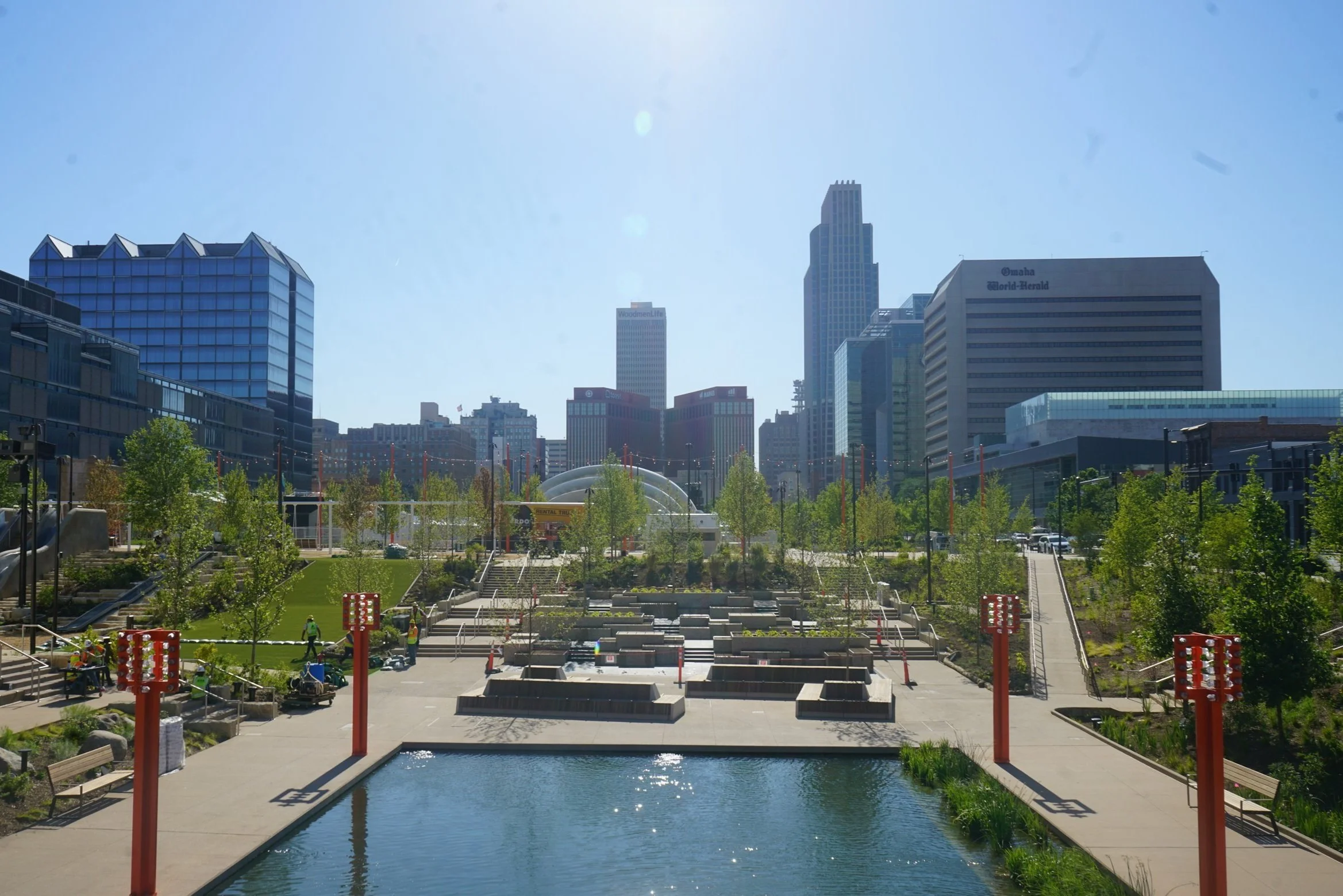Long Miles, Big Dollars: What Abortion for Nebraskans Looks Like Post Roe v. Wade
Nebrakans seeking an abortion in future years may have to travel to Minneapolis, eastern Colorado or southern Illinois, experts say. Pro-abortion rights advocates are making plans to open clinics and add staff in these areas, they told the Flatwater Free Press. Map by Hanscom Park Studio
By Yanqi Xu, Flatwater Free Press
Kim Young knows what it is like to travel hundreds of miles to have an abortion in a state she doesn’t call home.
Told no Planned Parenthood doctor in Nebraska could legally perform an abortion on her, she got in a car with her husband Damon and drove toward Des Moines just before Christmas, 1998.
Young, then a mother of two roughly 20 weeks pregnant, had an ultrasound showing that the brain and skull of the potato-sized fetus inside her wouldn’t fully form, a fatal birth defect called anencephaly.
Now she was terminating the pregnancy two-and-a-half hours from her Omaha home. She says she felt like she was “being chased” to Des Moines.
“Just the sheer legality of having to leave state lines to be able to do that is a very overwhelming and terrifying feeling,” Young, now 50, told the Flatwater Free Press. “You’re kind of in an unfamiliar no man’s land and you just don’t know.”
As soon as this summer, every Nebraskan seeking a legal abortion may have to cross state lines to reach a clinic, like Young once did. And, within a few years, Nebraskans seeking an abortion may have to go much farther than Des Moines. National experts and local advocates both suggest that Nebraskans may have to travel hundreds of miles and spend money on flights and hotel rooms to reach a clinic where abortion is legal.
Many who have fought against abortion cheer this potential change. They contend that Nebraska is a socially conservative state where abortion should be – and eventually will be – banned.
“We don’t believe abortion should be legal. And we’re working toward a future where it is illegal,” said Marion Miner, associate director of Pro-Life and Family Policy at the Nebraska Catholic Conference.
Pro-abortion rights advocates, meanwhile, are already preparing for a future where Omahans seeking an abortion might travel to a cluster of clinics across the Illinois border from St. Louis.
Other Nebraskans might head north, to Minnesota, where Planned Parenthood is looking to increase staffing levels and add clinics to deal with an influx of patients.
And residents of central Nebraska could head west, to Denver or mobile clinics popping up near the Colorado border.
“We’ve been preparing for the worst case scenario, which now we know is most likely our reality,” said Chelsea Souder, director of abortion fund Nebraska Abortion Resources.
The potential impact on Nebraskans hinges on three factors.
Pro-abortion rights advocates protested in front of the Omaha-Douglas Civic Center May 3, holding signs, listening to speeches and chanting “Bans off our bodies.” Yanqi Xu/Flatwater Free Press
One: The Supreme Court must overturn Roe v. Wade, which appears likely after a leaked draft opinion suggested a five-justice majority supports reversing the decision that has protected the right to an abortion since 1973.
Two: Anti-abortion Nebraska state senators must cobble together 33 votes to ban abortion in the state. That’s a number they failed to reach in April, though there are signs that they could succeed during a special session this summer, or during the next regular session this winter.
And three: If abortion is banned in Nebraska, the future of abortion in Iowa and Kansas will determine how far Nebraskans must travel. That future is contingent on court fights, potential constitutional amendments and new legislation in those states. Other neighbors – South Dakota, Wyoming and Missouri – have so-called “trigger bans” that go into effect if Roe is overturned.
Even though abortion is currently legal in Nebraska, accessing it is already difficult for many.
The state has three in-state providers, but all are located on Nebraska’s eastern edge:
The Bellevue clinic run by Dr. LeRoy Carhart and two Planned Parenthood locations in Lincoln and Omaha. Receiving abortion pills through telehealth is not allowed in Nebraska.
Nebraska is, in fact, one of a handful of states where residents must travel the farthest to reach an abortion clinic, according to analysis by Caitlin Myers, a Middlebury College economics professor and abortion access expert.
Residents in 70 of Nebraska’s 93 counties must travel more than 50 miles to the nearest abortion clinic, Myers’ research shows. Residents of 41 Nebraska counties currently find their closest clinic in a neighboring state.
This distance matters, experts say.
Adding 100 miles in travel to an abortion clinic stops 20% of women from accessing it, Myers’ research found.
Using projections that abortion would be banned in Nebraska and Iowa after the Supreme Court overturns Roe, Myers estimates that the eastern half of Nebraska would see a markedly lower number of abortions, with Omaha and Lincoln residents experiencing a 25% drop in abortion rates.
Applauding the draft opinion, anti-abortion groups in Nebraska are now working with legislators to further restrict or outlaw abortion in Nebraska.
“Certainly, those of us who work in this area would love to see no child sacrifice,” said Sandy Danek, executive director of Nebraska Right to Life.
Abortion activists have tried for years to ramp up staffing capacity at clinics in “safe haven states” with more protection, Souder said. They are also seeking to educate patients on abortion pills and navigating the system.
Two mobile clinics will begin traveling near the eastern Colorado border in June. Just the Pill, the operator of these mobile clinics, said they expect the need to grow significantly if Nebraska passes an abortion ban.
A Tennessee provider just announced the opening of a clinic in Carbondale, Ill., near St. Louis. Carbondale is 534 miles and an 8-hour drive from Omaha.
This distance – and the related cost – will disproportionately impact Nebraskans lower on the socioeconomic ladder, local experts say.
An out-of-state abortion costs between $3,000 and $8,000, Souder said, including the procedure and travel costs.
It matters whether a person has a car and can drive to another state or buy flights, said Kelly Jones, an American University economics professor who has studied the economics of abortion access. It matters whether they can afford child care. It matters whether their job allows sick time, whether they can pay for a hotel room, whether they are Internet savvy and can order abortion pills from elsewhere.
Teenagers and young adults, people of color, LGBTQ people and those with disabilities will be most impacted by an abortion ban leaving them hundreds of miles from the nearest clinic, said Souder and Sofia Jawed-Wessel, a University of Nebraska at Omaha public health professor and expert on sexual health. “We are going to leave some people behind,” Jawed-Wessel said.
Brandi Bothe, co-chair of the Omaha Women’s Day March, speaks to pro-abortion rights supporters at a May 3 rally in front of the Omaha-Douglas Civic Center. Yanqi Xu/Flatwater Free Press
Advocates for nationwide abortion access also repeatedly raised the prospect that banning abortion in Nebraska will lead to more residents resorting to an illegal abortion.
Earlier this year, Souder helped a Central Nebraska woman get on a flight to southern Illinois. She was 23 weeks pregnant, a stage too late for a physician to legally perform an abortion in Nebraska.
“She was really desperate for care and disclosed that if she couldn’t get out of the state… even though we were providing some support…she was just contemplating taking care of it on her own, whatever that means,” Souder said.
The Nebraska Legislature may take up an abortion ban bill as soon as this summer. The vote, if it does happen, will almost certainly be close.
Speaker of the Legislature Sen. Mike Hilgers, a Lincoln Republican, has said he will call a special session if the Supreme Court strikes down Roe. Hilgers and other abortion opponents will need 33 votes to overcome a filibuster.
Hilgers did not return phone messages for comment.
Sen. Megan Hunt, an Omaha Democrat and supporter of abortion rights, told the Flatwater Free Press that if a special session is called, she will make it “the most excruciating, painful political experience that my colleagues have ever had.”
Abortion opponents narrowly missed passing an abortion ban in April.
LB 933, a bill that would have outlawed abortion and offered no exception if the pregnant Nebraskan was a victim of rape or incest, received 31 votes – two short.
But two state senators could change the outcome. A new senator, appointed by Gov. Pete Ricketts to replace late Sen. Rich Pahls, could move supporters of a ban to within a single vote of victory.
And Sen. Justin Wayne, Omaha Democrat, is believed to be the potential 33rd – and most crucial – vote.
Fellow Democrats and pro-abortion rights advocates have expressed worry for weeks that Wayne, absent from the Legislature the day of the LB 933 vote, may end up voting to ban abortion during a special session.
Wayne didn’t respond to multiple interview requests left by phone and email.
Aides of Sen. Joni Albrecht, sponsor of LB 933, cited a busy schedule as the reason she couldn’t respond to an interview request Wednesday. Sen. Lou Ann Linehan and Sen. Julie Slama, didn’t return phone calls to their legislative offices seeking comment. Sen. Rita Sanders declined an interview request.
Even if no special session is called, the new Legislature may introduce a similar abortion ban this winter. Nearly half of the 49 legislative seats are up for election this November.
Nebraska’s neighbors are also girding for a post-Roe fight. Both Iowa and Kansas must rescind their current constitutional protections of abortion rights in order to ban abortion.
In Iowa, this could happen as early as June in a state Supreme Court ruling, or through a constitutional amendment in 2023 or 2024.
Kansans will vote in August on a constitutional amendment to undo its protection of abortion.
An abortion ban would then fall to those states’ legislators. Iowa’s Republican governor supports an abortion ban, while Kansas’ Democratic governor seems likely to veto laws banning abortion.
As the Nebraska Legislature deliberates the future of abortion, what has happened after Texas’ rollback of abortion access may serve as a lesson.
After Texas banned abortions around six weeks in its “Heartbeat Act” last year, an abortion fund serving 110 North Texas counties saw their call volume plunge by half, said Charlie Hughes, the fund’s intake director. Texans who want an abortion must travel long distances – distances similar to what Nebraskans seeking an abortion may soon have to travel.
“A lot of people were going to Oklahoma, but then that was also offsetting people in Oklahoma, and they had to go to Kansas,” Hughes said. “It was just kind of this geographical migration [of people] trying to get an abortion.”
Flatwater Free Press
is Nebraska’s first independent, nonprofit newsroom focused on investigations and feature stories that matter.

















